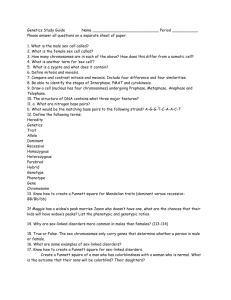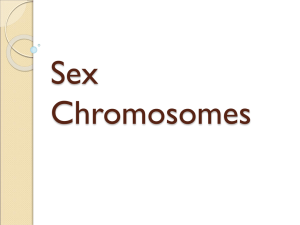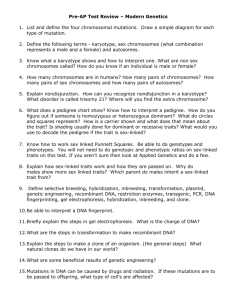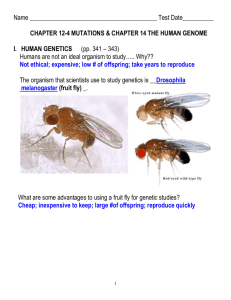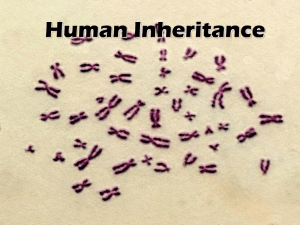Life Science
advertisement
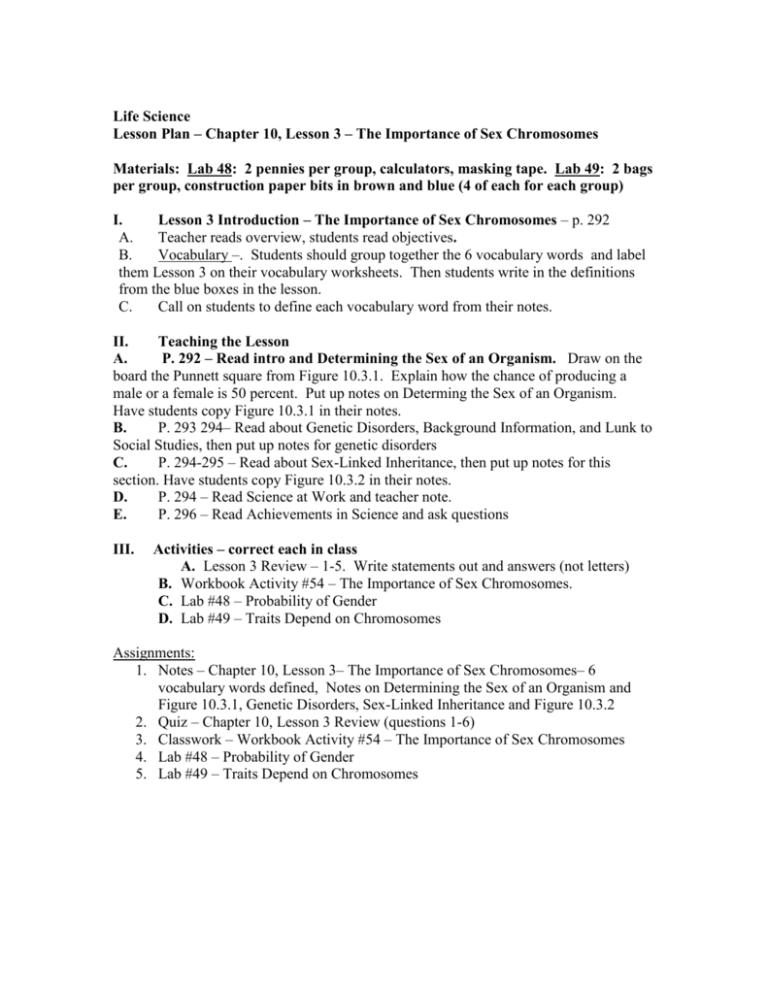
Life Science Lesson Plan – Chapter 10, Lesson 3 – The Importance of Sex Chromosomes Materials: Lab 48: 2 pennies per group, calculators, masking tape. Lab 49: 2 bags per group, construction paper bits in brown and blue (4 of each for each group) I. Lesson 3 Introduction – The Importance of Sex Chromosomes – p. 292 A. Teacher reads overview, students read objectives. B. Vocabulary –. Students should group together the 6 vocabulary words and label them Lesson 3 on their vocabulary worksheets. Then students write in the definitions from the blue boxes in the lesson. C. Call on students to define each vocabulary word from their notes. II. Teaching the Lesson A. P. 292 – Read intro and Determining the Sex of an Organism. Draw on the board the Punnett square from Figure 10.3.1. Explain how the chance of producing a male or a female is 50 percent. Put up notes on Determing the Sex of an Organism. Have students copy Figure 10.3.1 in their notes. B. P. 293 294– Read about Genetic Disorders, Background Information, and Lunk to Social Studies, then put up notes for genetic disorders C. P. 294-295 – Read about Sex-Linked Inheritance, then put up notes for this section. Have students copy Figure 10.3.2 in their notes. D. P. 294 – Read Science at Work and teacher note. E. P. 296 – Read Achievements in Science and ask questions III. Activities – correct each in class A. Lesson 3 Review – 1-5. Write statements out and answers (not letters) B. Workbook Activity #54 – The Importance of Sex Chromosomes. C. Lab #48 – Probability of Gender D. Lab #49 – Traits Depend on Chromosomes Assignments: 1. Notes – Chapter 10, Lesson 3– The Importance of Sex Chromosomes– 6 vocabulary words defined, Notes on Determining the Sex of an Organism and Figure 10.3.1, Genetic Disorders, Sex-Linked Inheritance and Figure 10.3.2 2. Quiz – Chapter 10, Lesson 3 Review (questions 1-6) 3. Classwork – Workbook Activity #54 – The Importance of Sex Chromosomes 4. Lab #48 – Probability of Gender 5. Lab #49 – Traits Depend on Chromosomes Chapter 10, Lesson 3 Notes The Importance of Sex Chromosomes Determining the Sex of an Organism Humans have two types of sex chromosomes, X and Y. A human zygote with two X chromosomes (XX) is female. A human zygote with one X and one Y chromosome (XY) is male. The sex of an offspring depends on the Y chromosome found in sperm. If a Y chromosome is present, the zygote becomes male. If the Y chromosome is not present, the zygote becomes female. Insects have a ZW chromosome system. Two Z’s =males; Females = Z and W. (Draw and label Figure 10.3.1 on p. 292) Genetic Disorders X chromosomes carry the most traits, including sex-linked traits and eye color. Genes on the X chromosome control genetic diseases such as hemophilia. Hemophilia is also sex-linked. Genes that are sex-linked are inherited differently in males and females. Sex-linked disorders usually occur in men because they have only 1 X chromosome. If a man inherits a sex-linked disorder, he will express the allele even if it is recessive because he does not have a second X chromosome. Fruit Fly Inheritance Traits The allele for red eyes is dominant in fruit flies; therefore, fruit flies usually have red eyes. Eye-color in fruit flies is a sex-linked trait; all white-eyed flies are male. (Draw and label Figure 10.3.2 on p. 295)

